Environmental Impact Assessment of Land Contamination in Pakistan
VerifiedAdded on 2021/04/17
|22
|5478
|170
Report
AI Summary
This report provides a comprehensive environmental impact assessment of land contamination in Pakistan, focusing on the sources, extent, and consequences of pollution. The study examines various heavy metals like arsenic, cadmium, and lead, highlighting their adverse effects on human health and the environment. It reviews existing literature, analyzes contamination sites, and employs statistical surveys to assess the severity of the problem. The methodology includes site assessments, exposure evaluations, and the identification of hazardous areas. The findings reveal significant levels of pollution stemming from both natural and anthropogenic sources, including industrial emissions and agricultural practices. The report concludes with recommendations for mitigating land contamination, emphasizing the need for reduced industrial pollution and improved waste management to safeguard public health and environmental integrity. This assignment, available on Desklib, offers valuable insights for students studying environmental science and engineering.
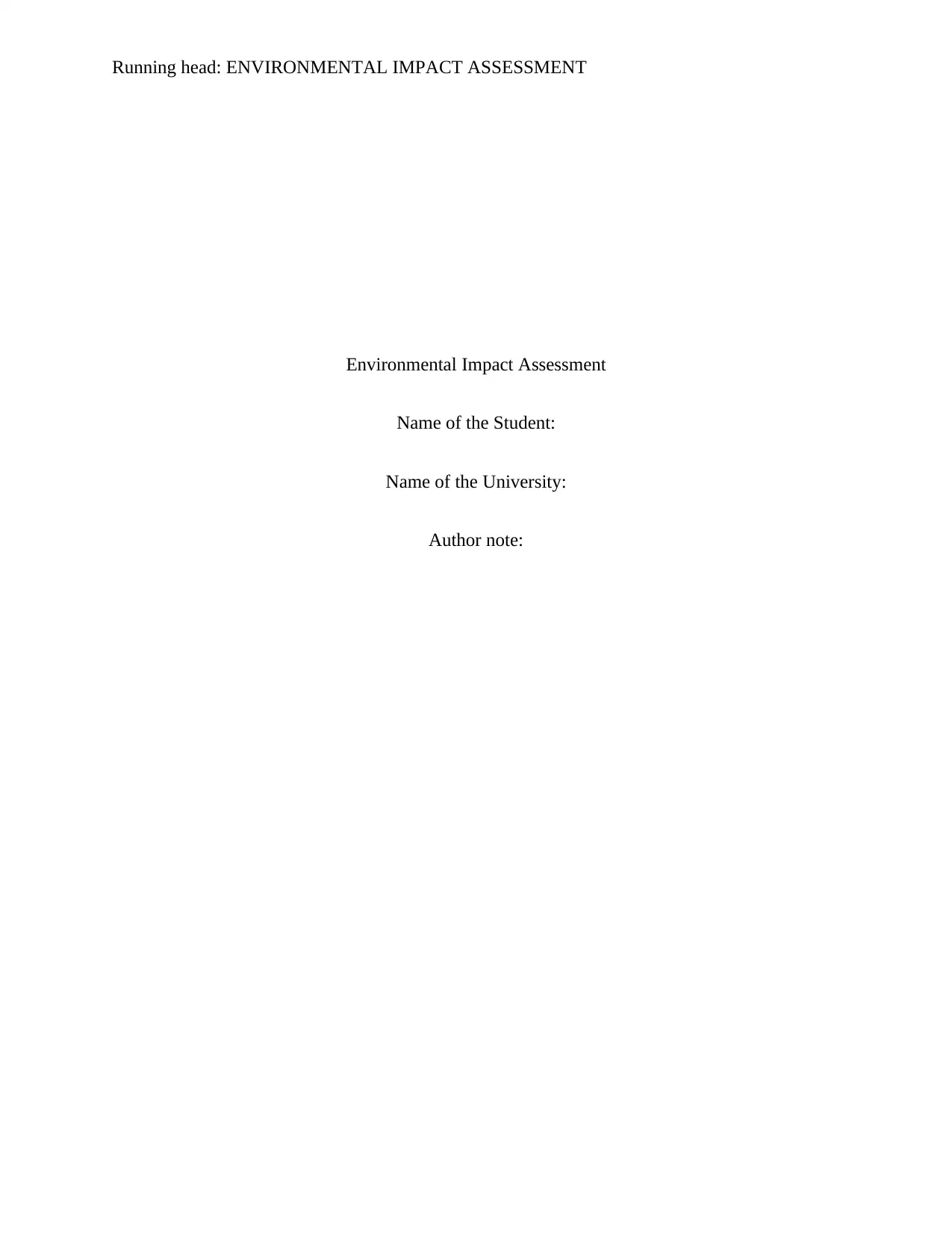
Running head: ENVIRONMENTAL IMPACT ASSESSMENT
Environmental Impact Assessment
Name of the Student:
Name of the University:
Author note:
Environmental Impact Assessment
Name of the Student:
Name of the University:
Author note:
Paraphrase This Document
Need a fresh take? Get an instant paraphrase of this document with our AI Paraphraser
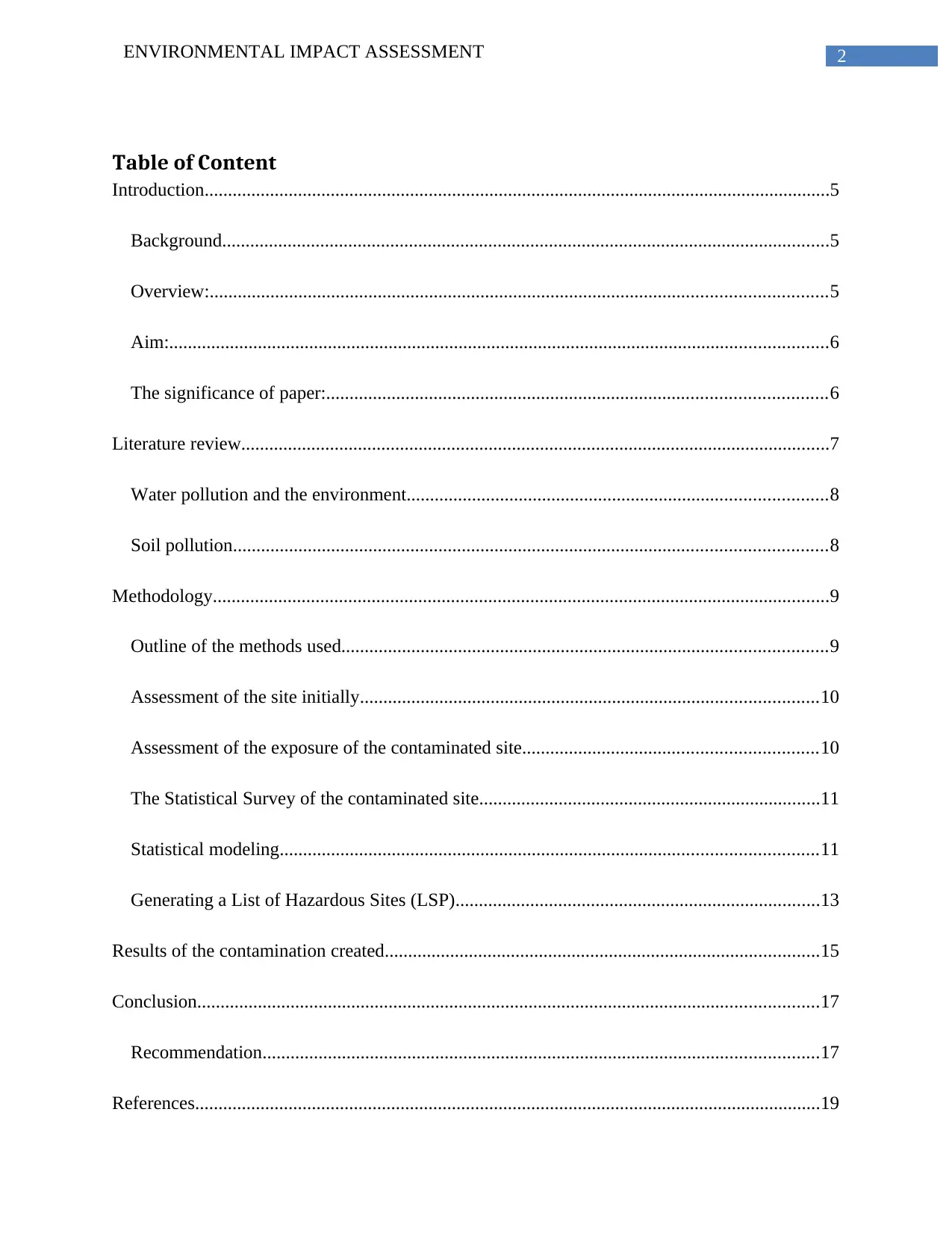
2ENVIRONMENTAL IMPACT ASSESSMENT
Table of Content
Introduction......................................................................................................................................5
Background..................................................................................................................................5
Overview:....................................................................................................................................5
Aim:.............................................................................................................................................6
The significance of paper:...........................................................................................................6
Literature review..............................................................................................................................7
Water pollution and the environment..........................................................................................8
Soil pollution...............................................................................................................................8
Methodology....................................................................................................................................9
Outline of the methods used........................................................................................................9
Assessment of the site initially..................................................................................................10
Assessment of the exposure of the contaminated site...............................................................10
The Statistical Survey of the contaminated site.........................................................................11
Statistical modeling...................................................................................................................11
Generating a List of Hazardous Sites (LSP)..............................................................................13
Results of the contamination created.............................................................................................15
Conclusion.....................................................................................................................................17
Recommendation.......................................................................................................................17
References......................................................................................................................................19
Table of Content
Introduction......................................................................................................................................5
Background..................................................................................................................................5
Overview:....................................................................................................................................5
Aim:.............................................................................................................................................6
The significance of paper:...........................................................................................................6
Literature review..............................................................................................................................7
Water pollution and the environment..........................................................................................8
Soil pollution...............................................................................................................................8
Methodology....................................................................................................................................9
Outline of the methods used........................................................................................................9
Assessment of the site initially..................................................................................................10
Assessment of the exposure of the contaminated site...............................................................10
The Statistical Survey of the contaminated site.........................................................................11
Statistical modeling...................................................................................................................11
Generating a List of Hazardous Sites (LSP)..............................................................................13
Results of the contamination created.............................................................................................15
Conclusion.....................................................................................................................................17
Recommendation.......................................................................................................................17
References......................................................................................................................................19

3ENVIRONMENTAL IMPACT ASSESSMENT
⊘ This is a preview!⊘
Do you want full access?
Subscribe today to unlock all pages.

Trusted by 1+ million students worldwide

4ENVIRONMENTAL IMPACT ASSESSMENT
Abstract
This paper examines the various metals that are associated with land contamination for instances
arsenic, cadmium, lead, chromium, nickel and mercury which are well known as the ingredient
of contamination of the ecology in the region where there is a high rate of anthropogenic burden.
This research is mainly based on the land contamination that occurs in Pakistan. The researchers
have used the quantitative method of research which is used to analyze the most recent literature
available on the land contamination of Pakistan. The three main steps followed to analyze are
first, assessment of the site initially, secondly, assessment of the exposure of the contaminated
site which also contains a survey of few places and the amount of contamination found, thirdly,
remediation of the site. The finding revealed that the contamination in Pakistan is both men made
as well due to the terrain they belong to which contains various anthropogenic elements which
are harmful to live beings. Additionally, it is evident that the different elements which can cause
soil contamination are higher in many places in Pakistan than the standard or tolerable rate
mentioned by WHO and other survey board. Lastly, the paper confirms that the pollution can be
reduced only if there is a reduction in the manmade cause of the land contamination such as oil
spill and other industrial emissions which constitute most of Pakistan’s land contamination.
Abstract
This paper examines the various metals that are associated with land contamination for instances
arsenic, cadmium, lead, chromium, nickel and mercury which are well known as the ingredient
of contamination of the ecology in the region where there is a high rate of anthropogenic burden.
This research is mainly based on the land contamination that occurs in Pakistan. The researchers
have used the quantitative method of research which is used to analyze the most recent literature
available on the land contamination of Pakistan. The three main steps followed to analyze are
first, assessment of the site initially, secondly, assessment of the exposure of the contaminated
site which also contains a survey of few places and the amount of contamination found, thirdly,
remediation of the site. The finding revealed that the contamination in Pakistan is both men made
as well due to the terrain they belong to which contains various anthropogenic elements which
are harmful to live beings. Additionally, it is evident that the different elements which can cause
soil contamination are higher in many places in Pakistan than the standard or tolerable rate
mentioned by WHO and other survey board. Lastly, the paper confirms that the pollution can be
reduced only if there is a reduction in the manmade cause of the land contamination such as oil
spill and other industrial emissions which constitute most of Pakistan’s land contamination.
Paraphrase This Document
Need a fresh take? Get an instant paraphrase of this document with our AI Paraphraser
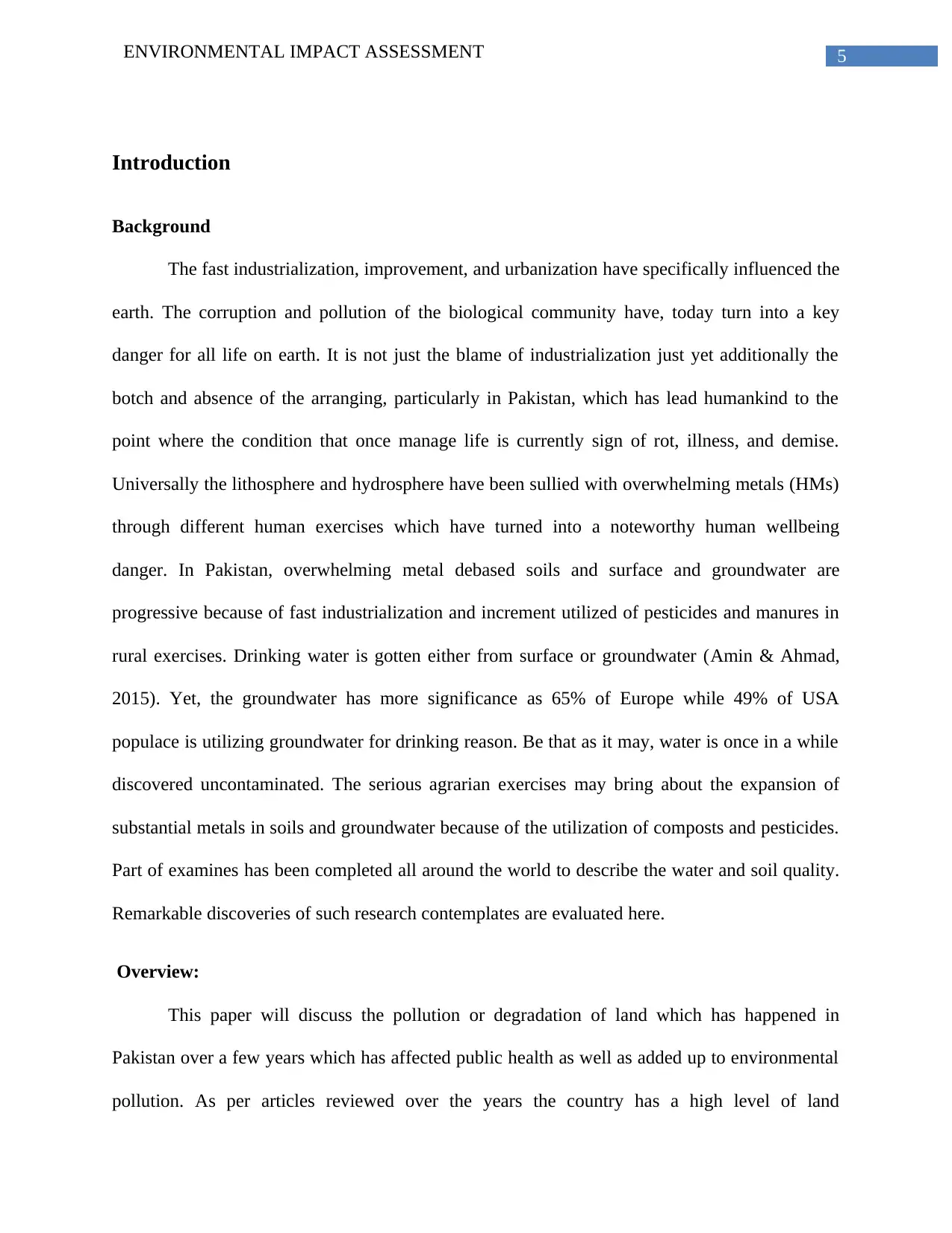
5ENVIRONMENTAL IMPACT ASSESSMENT
Introduction
Background
The fast industrialization, improvement, and urbanization have specifically influenced the
earth. The corruption and pollution of the biological community have, today turn into a key
danger for all life on earth. It is not just the blame of industrialization just yet additionally the
botch and absence of the arranging, particularly in Pakistan, which has lead humankind to the
point where the condition that once manage life is currently sign of rot, illness, and demise.
Universally the lithosphere and hydrosphere have been sullied with overwhelming metals (HMs)
through different human exercises which have turned into a noteworthy human wellbeing
danger. In Pakistan, overwhelming metal debased soils and surface and groundwater are
progressive because of fast industrialization and increment utilized of pesticides and manures in
rural exercises. Drinking water is gotten either from surface or groundwater (Amin & Ahmad,
2015). Yet, the groundwater has more significance as 65% of Europe while 49% of USA
populace is utilizing groundwater for drinking reason. Be that as it may, water is once in a while
discovered uncontaminated. The serious agrarian exercises may bring about the expansion of
substantial metals in soils and groundwater because of the utilization of composts and pesticides.
Part of examines has been completed all around the world to describe the water and soil quality.
Remarkable discoveries of such research contemplates are evaluated here.
Overview:
This paper will discuss the pollution or degradation of land which has happened in
Pakistan over a few years which has affected public health as well as added up to environmental
pollution. As per articles reviewed over the years the country has a high level of land
Introduction
Background
The fast industrialization, improvement, and urbanization have specifically influenced the
earth. The corruption and pollution of the biological community have, today turn into a key
danger for all life on earth. It is not just the blame of industrialization just yet additionally the
botch and absence of the arranging, particularly in Pakistan, which has lead humankind to the
point where the condition that once manage life is currently sign of rot, illness, and demise.
Universally the lithosphere and hydrosphere have been sullied with overwhelming metals (HMs)
through different human exercises which have turned into a noteworthy human wellbeing
danger. In Pakistan, overwhelming metal debased soils and surface and groundwater are
progressive because of fast industrialization and increment utilized of pesticides and manures in
rural exercises. Drinking water is gotten either from surface or groundwater (Amin & Ahmad,
2015). Yet, the groundwater has more significance as 65% of Europe while 49% of USA
populace is utilizing groundwater for drinking reason. Be that as it may, water is once in a while
discovered uncontaminated. The serious agrarian exercises may bring about the expansion of
substantial metals in soils and groundwater because of the utilization of composts and pesticides.
Part of examines has been completed all around the world to describe the water and soil quality.
Remarkable discoveries of such research contemplates are evaluated here.
Overview:
This paper will discuss the pollution or degradation of land which has happened in
Pakistan over a few years which has affected public health as well as added up to environmental
pollution. As per articles reviewed over the years the country has a high level of land
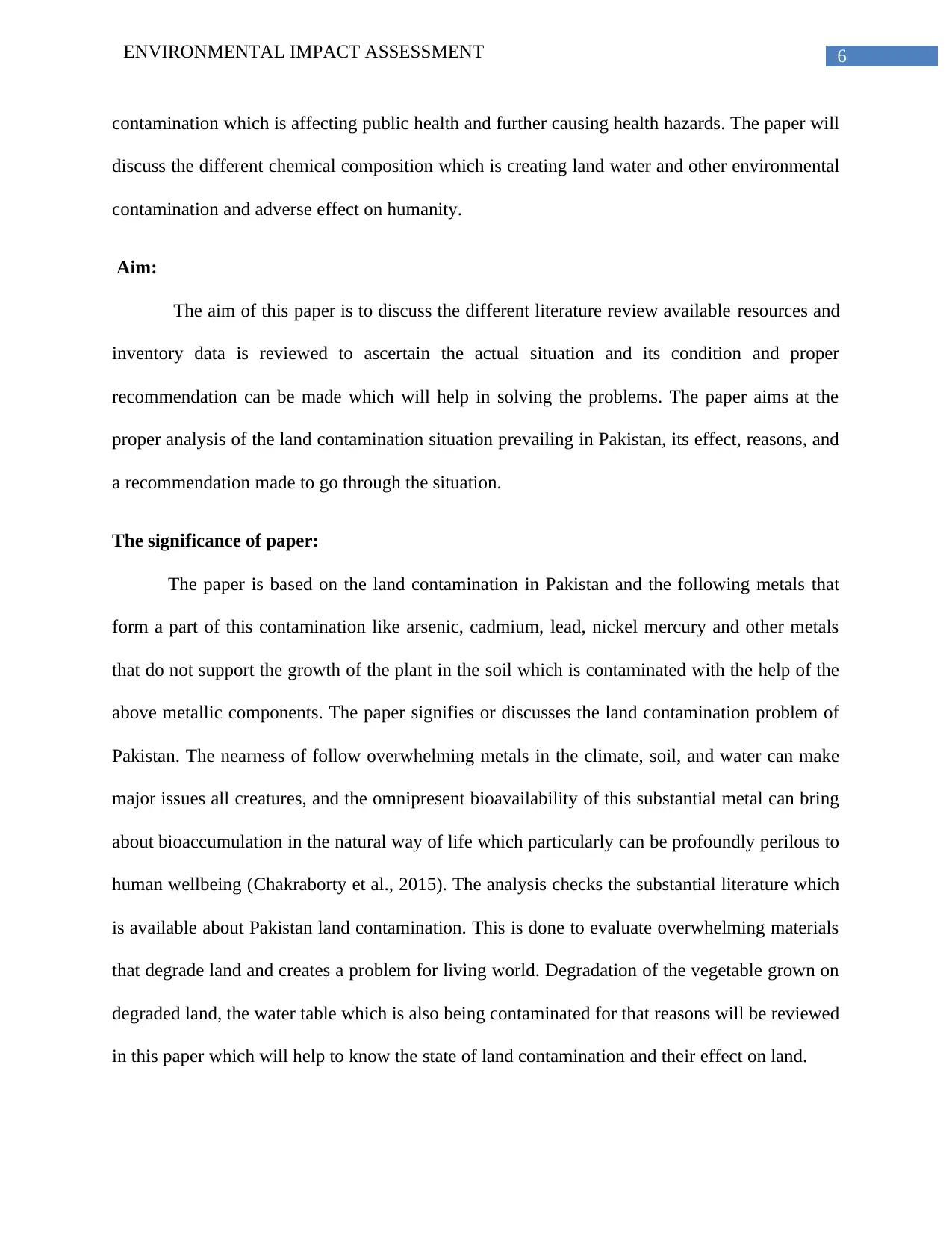
6ENVIRONMENTAL IMPACT ASSESSMENT
contamination which is affecting public health and further causing health hazards. The paper will
discuss the different chemical composition which is creating land water and other environmental
contamination and adverse effect on humanity.
Aim:
The aim of this paper is to discuss the different literature review available resources and
inventory data is reviewed to ascertain the actual situation and its condition and proper
recommendation can be made which will help in solving the problems. The paper aims at the
proper analysis of the land contamination situation prevailing in Pakistan, its effect, reasons, and
a recommendation made to go through the situation.
The significance of paper:
The paper is based on the land contamination in Pakistan and the following metals that
form a part of this contamination like arsenic, cadmium, lead, nickel mercury and other metals
that do not support the growth of the plant in the soil which is contaminated with the help of the
above metallic components. The paper signifies or discusses the land contamination problem of
Pakistan. The nearness of follow overwhelming metals in the climate, soil, and water can make
major issues all creatures, and the omnipresent bioavailability of this substantial metal can bring
about bioaccumulation in the natural way of life which particularly can be profoundly perilous to
human wellbeing (Chakraborty et al., 2015). The analysis checks the substantial literature which
is available about Pakistan land contamination. This is done to evaluate overwhelming materials
that degrade land and creates a problem for living world. Degradation of the vegetable grown on
degraded land, the water table which is also being contaminated for that reasons will be reviewed
in this paper which will help to know the state of land contamination and their effect on land.
contamination which is affecting public health and further causing health hazards. The paper will
discuss the different chemical composition which is creating land water and other environmental
contamination and adverse effect on humanity.
Aim:
The aim of this paper is to discuss the different literature review available resources and
inventory data is reviewed to ascertain the actual situation and its condition and proper
recommendation can be made which will help in solving the problems. The paper aims at the
proper analysis of the land contamination situation prevailing in Pakistan, its effect, reasons, and
a recommendation made to go through the situation.
The significance of paper:
The paper is based on the land contamination in Pakistan and the following metals that
form a part of this contamination like arsenic, cadmium, lead, nickel mercury and other metals
that do not support the growth of the plant in the soil which is contaminated with the help of the
above metallic components. The paper signifies or discusses the land contamination problem of
Pakistan. The nearness of follow overwhelming metals in the climate, soil, and water can make
major issues all creatures, and the omnipresent bioavailability of this substantial metal can bring
about bioaccumulation in the natural way of life which particularly can be profoundly perilous to
human wellbeing (Chakraborty et al., 2015). The analysis checks the substantial literature which
is available about Pakistan land contamination. This is done to evaluate overwhelming materials
that degrade land and creates a problem for living world. Degradation of the vegetable grown on
degraded land, the water table which is also being contaminated for that reasons will be reviewed
in this paper which will help to know the state of land contamination and their effect on land.
⊘ This is a preview!⊘
Do you want full access?
Subscribe today to unlock all pages.

Trusted by 1+ million students worldwide
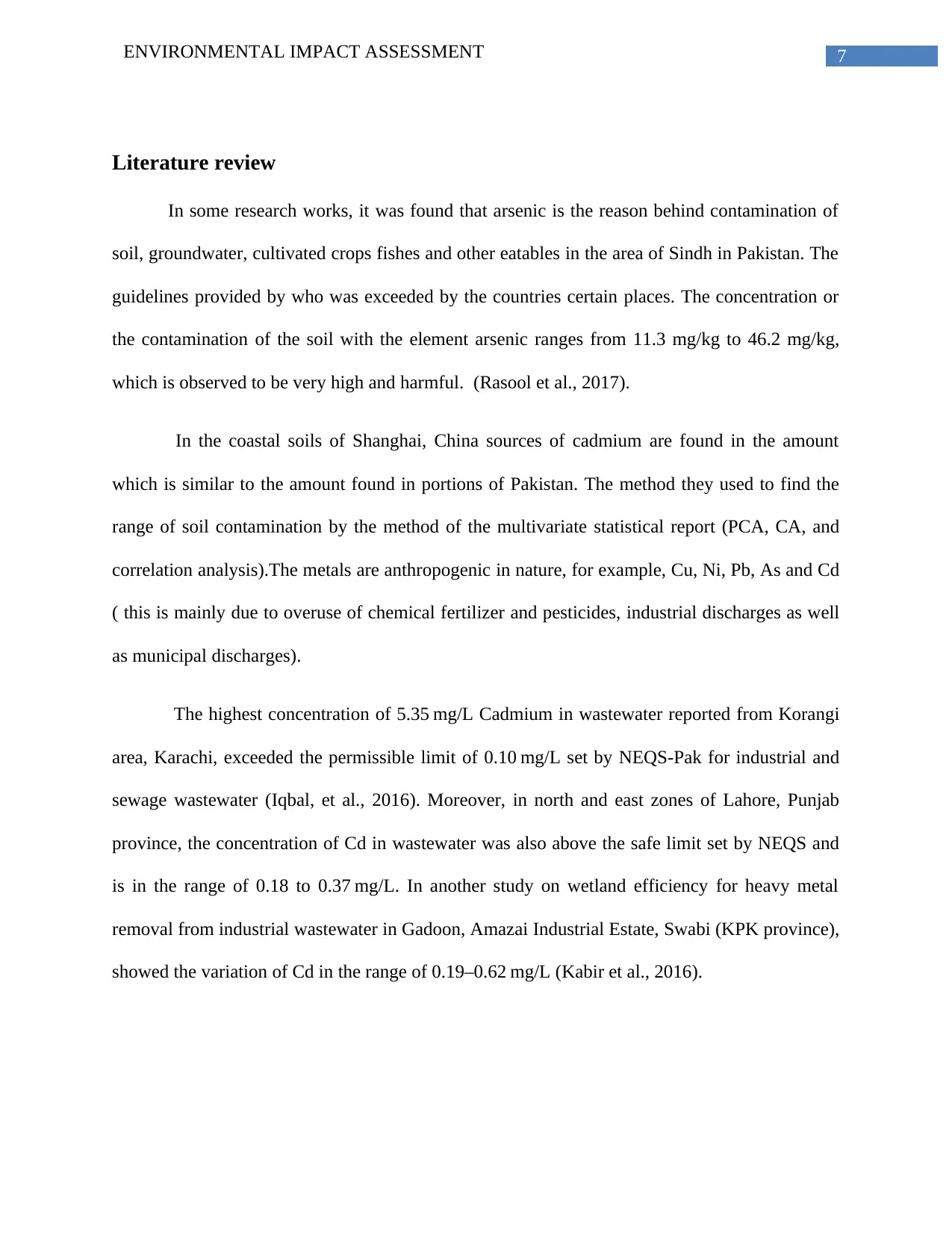
7ENVIRONMENTAL IMPACT ASSESSMENT
Literature review
In some research works, it was found that arsenic is the reason behind contamination of
soil, groundwater, cultivated crops fishes and other eatables in the area of Sindh in Pakistan. The
guidelines provided by who was exceeded by the countries certain places. The concentration or
the contamination of the soil with the element arsenic ranges from 11.3 mg/kg to 46.2 mg/kg,
which is observed to be very high and harmful. (Rasool et al., 2017).
In the coastal soils of Shanghai, China sources of cadmium are found in the amount
which is similar to the amount found in portions of Pakistan. The method they used to find the
range of soil contamination by the method of the multivariate statistical report (PCA, CA, and
correlation analysis).The metals are anthropogenic in nature, for example, Cu, Ni, Pb, As and Cd
( this is mainly due to overuse of chemical fertilizer and pesticides, industrial discharges as well
as municipal discharges).
The highest concentration of 5.35 mg/L Cadmium in wastewater reported from Korangi
area, Karachi, exceeded the permissible limit of 0.10 mg/L set by NEQS-Pak for industrial and
sewage wastewater (Iqbal, et al., 2016). Moreover, in north and east zones of Lahore, Punjab
province, the concentration of Cd in wastewater was also above the safe limit set by NEQS and
is in the range of 0.18 to 0.37 mg/L. In another study on wetland efficiency for heavy metal
removal from industrial wastewater in Gadoon, Amazai Industrial Estate, Swabi (KPK province),
showed the variation of Cd in the range of 0.19–0.62 mg/L (Kabir et al., 2016).
Literature review
In some research works, it was found that arsenic is the reason behind contamination of
soil, groundwater, cultivated crops fishes and other eatables in the area of Sindh in Pakistan. The
guidelines provided by who was exceeded by the countries certain places. The concentration or
the contamination of the soil with the element arsenic ranges from 11.3 mg/kg to 46.2 mg/kg,
which is observed to be very high and harmful. (Rasool et al., 2017).
In the coastal soils of Shanghai, China sources of cadmium are found in the amount
which is similar to the amount found in portions of Pakistan. The method they used to find the
range of soil contamination by the method of the multivariate statistical report (PCA, CA, and
correlation analysis).The metals are anthropogenic in nature, for example, Cu, Ni, Pb, As and Cd
( this is mainly due to overuse of chemical fertilizer and pesticides, industrial discharges as well
as municipal discharges).
The highest concentration of 5.35 mg/L Cadmium in wastewater reported from Korangi
area, Karachi, exceeded the permissible limit of 0.10 mg/L set by NEQS-Pak for industrial and
sewage wastewater (Iqbal, et al., 2016). Moreover, in north and east zones of Lahore, Punjab
province, the concentration of Cd in wastewater was also above the safe limit set by NEQS and
is in the range of 0.18 to 0.37 mg/L. In another study on wetland efficiency for heavy metal
removal from industrial wastewater in Gadoon, Amazai Industrial Estate, Swabi (KPK province),
showed the variation of Cd in the range of 0.19–0.62 mg/L (Kabir et al., 2016).
Paraphrase This Document
Need a fresh take? Get an instant paraphrase of this document with our AI Paraphraser
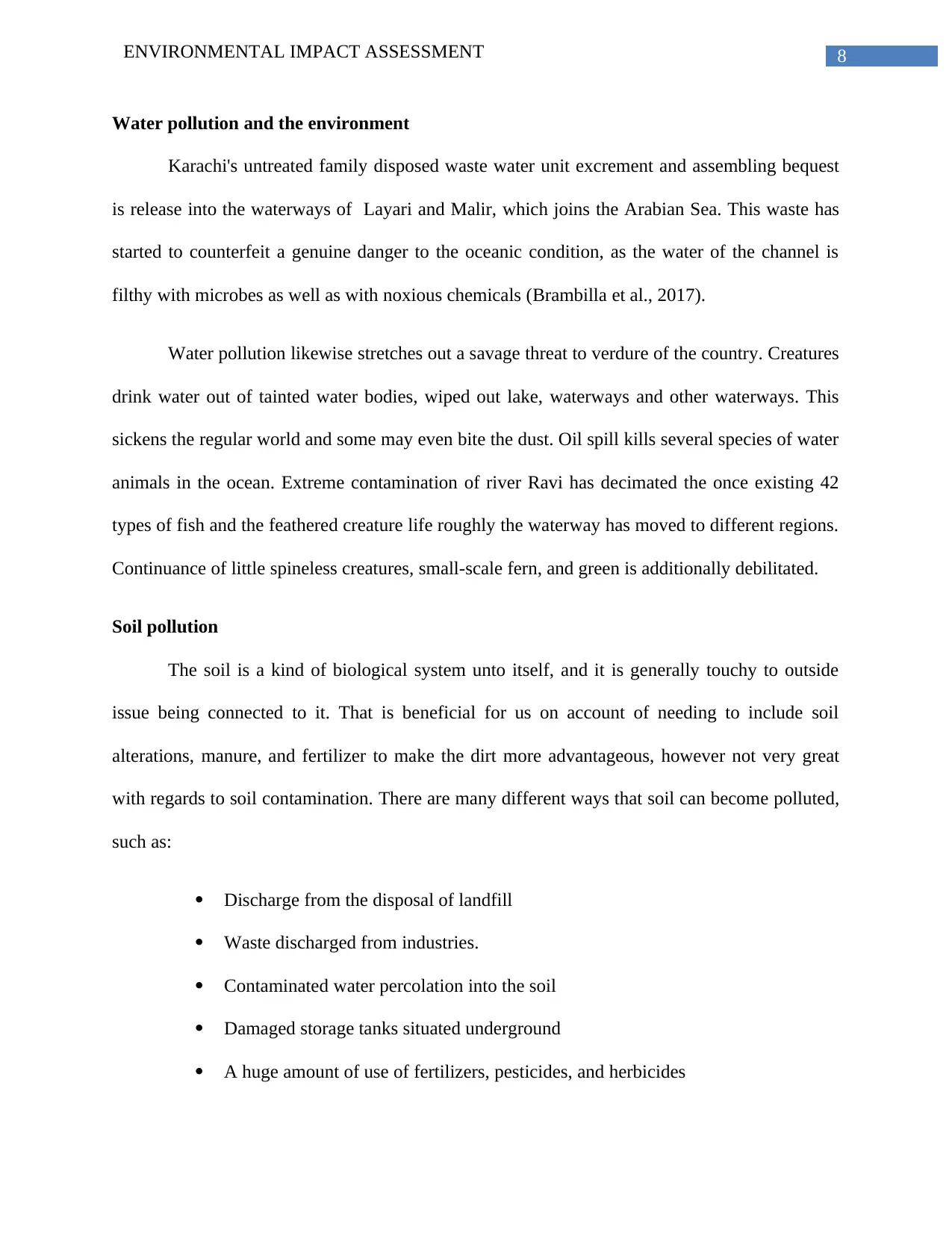
8ENVIRONMENTAL IMPACT ASSESSMENT
Water pollution and the environment
Karachi's untreated family disposed waste water unit excrement and assembling bequest
is release into the waterways of Layari and Malir, which joins the Arabian Sea. This waste has
started to counterfeit a genuine danger to the oceanic condition, as the water of the channel is
filthy with microbes as well as with noxious chemicals (Brambilla et al., 2017).
Water pollution likewise stretches out a savage threat to verdure of the country. Creatures
drink water out of tainted water bodies, wiped out lake, waterways and other waterways. This
sickens the regular world and some may even bite the dust. Oil spill kills several species of water
animals in the ocean. Extreme contamination of river Ravi has decimated the once existing 42
types of fish and the feathered creature life roughly the waterway has moved to different regions.
Continuance of little spineless creatures, small-scale fern, and green is additionally debilitated.
Soil pollution
The soil is a kind of biological system unto itself, and it is generally touchy to outside
issue being connected to it. That is beneficial for us on account of needing to include soil
alterations, manure, and fertilizer to make the dirt more advantageous, however not very great
with regards to soil contamination. There are many different ways that soil can become polluted,
such as:
Discharge from the disposal of landfill
Waste discharged from industries.
Contaminated water percolation into the soil
Damaged storage tanks situated underground
A huge amount of use of fertilizers, pesticides, and herbicides
Water pollution and the environment
Karachi's untreated family disposed waste water unit excrement and assembling bequest
is release into the waterways of Layari and Malir, which joins the Arabian Sea. This waste has
started to counterfeit a genuine danger to the oceanic condition, as the water of the channel is
filthy with microbes as well as with noxious chemicals (Brambilla et al., 2017).
Water pollution likewise stretches out a savage threat to verdure of the country. Creatures
drink water out of tainted water bodies, wiped out lake, waterways and other waterways. This
sickens the regular world and some may even bite the dust. Oil spill kills several species of water
animals in the ocean. Extreme contamination of river Ravi has decimated the once existing 42
types of fish and the feathered creature life roughly the waterway has moved to different regions.
Continuance of little spineless creatures, small-scale fern, and green is additionally debilitated.
Soil pollution
The soil is a kind of biological system unto itself, and it is generally touchy to outside
issue being connected to it. That is beneficial for us on account of needing to include soil
alterations, manure, and fertilizer to make the dirt more advantageous, however not very great
with regards to soil contamination. There are many different ways that soil can become polluted,
such as:
Discharge from the disposal of landfill
Waste discharged from industries.
Contaminated water percolation into the soil
Damaged storage tanks situated underground
A huge amount of use of fertilizers, pesticides, and herbicides
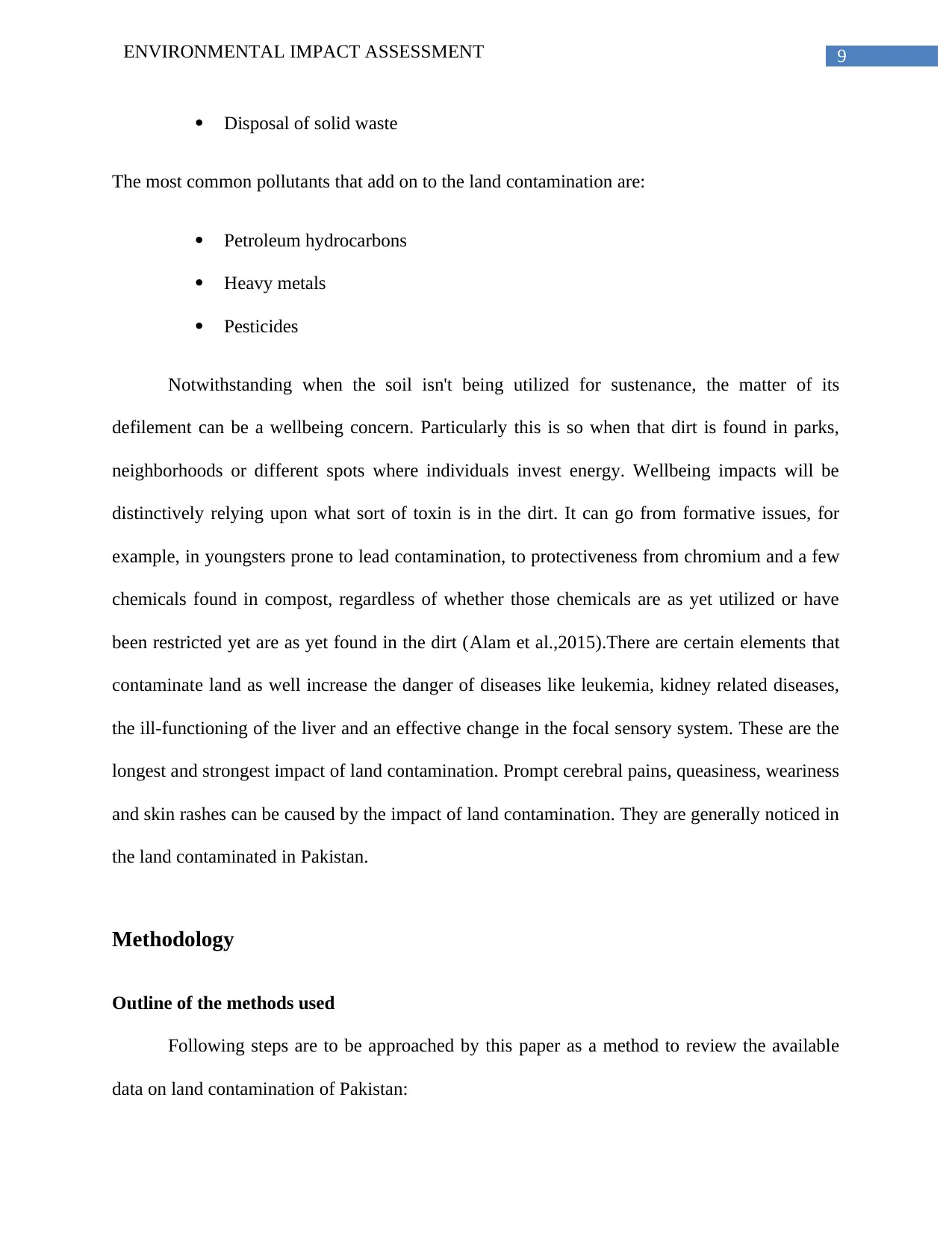
9ENVIRONMENTAL IMPACT ASSESSMENT
Disposal of solid waste
The most common pollutants that add on to the land contamination are:
Petroleum hydrocarbons
Heavy metals
Pesticides
Notwithstanding when the soil isn't being utilized for sustenance, the matter of its
defilement can be a wellbeing concern. Particularly this is so when that dirt is found in parks,
neighborhoods or different spots where individuals invest energy. Wellbeing impacts will be
distinctively relying upon what sort of toxin is in the dirt. It can go from formative issues, for
example, in youngsters prone to lead contamination, to protectiveness from chromium and a few
chemicals found in compost, regardless of whether those chemicals are as yet utilized or have
been restricted yet are as yet found in the dirt (Alam et al.,2015).There are certain elements that
contaminate land as well increase the danger of diseases like leukemia, kidney related diseases,
the ill-functioning of the liver and an effective change in the focal sensory system. These are the
longest and strongest impact of land contamination. Prompt cerebral pains, queasiness, weariness
and skin rashes can be caused by the impact of land contamination. They are generally noticed in
the land contaminated in Pakistan.
Methodology
Outline of the methods used
Following steps are to be approached by this paper as a method to review the available
data on land contamination of Pakistan:
Disposal of solid waste
The most common pollutants that add on to the land contamination are:
Petroleum hydrocarbons
Heavy metals
Pesticides
Notwithstanding when the soil isn't being utilized for sustenance, the matter of its
defilement can be a wellbeing concern. Particularly this is so when that dirt is found in parks,
neighborhoods or different spots where individuals invest energy. Wellbeing impacts will be
distinctively relying upon what sort of toxin is in the dirt. It can go from formative issues, for
example, in youngsters prone to lead contamination, to protectiveness from chromium and a few
chemicals found in compost, regardless of whether those chemicals are as yet utilized or have
been restricted yet are as yet found in the dirt (Alam et al.,2015).There are certain elements that
contaminate land as well increase the danger of diseases like leukemia, kidney related diseases,
the ill-functioning of the liver and an effective change in the focal sensory system. These are the
longest and strongest impact of land contamination. Prompt cerebral pains, queasiness, weariness
and skin rashes can be caused by the impact of land contamination. They are generally noticed in
the land contaminated in Pakistan.
Methodology
Outline of the methods used
Following steps are to be approached by this paper as a method to review the available
data on land contamination of Pakistan:
⊘ This is a preview!⊘
Do you want full access?
Subscribe today to unlock all pages.

Trusted by 1+ million students worldwide
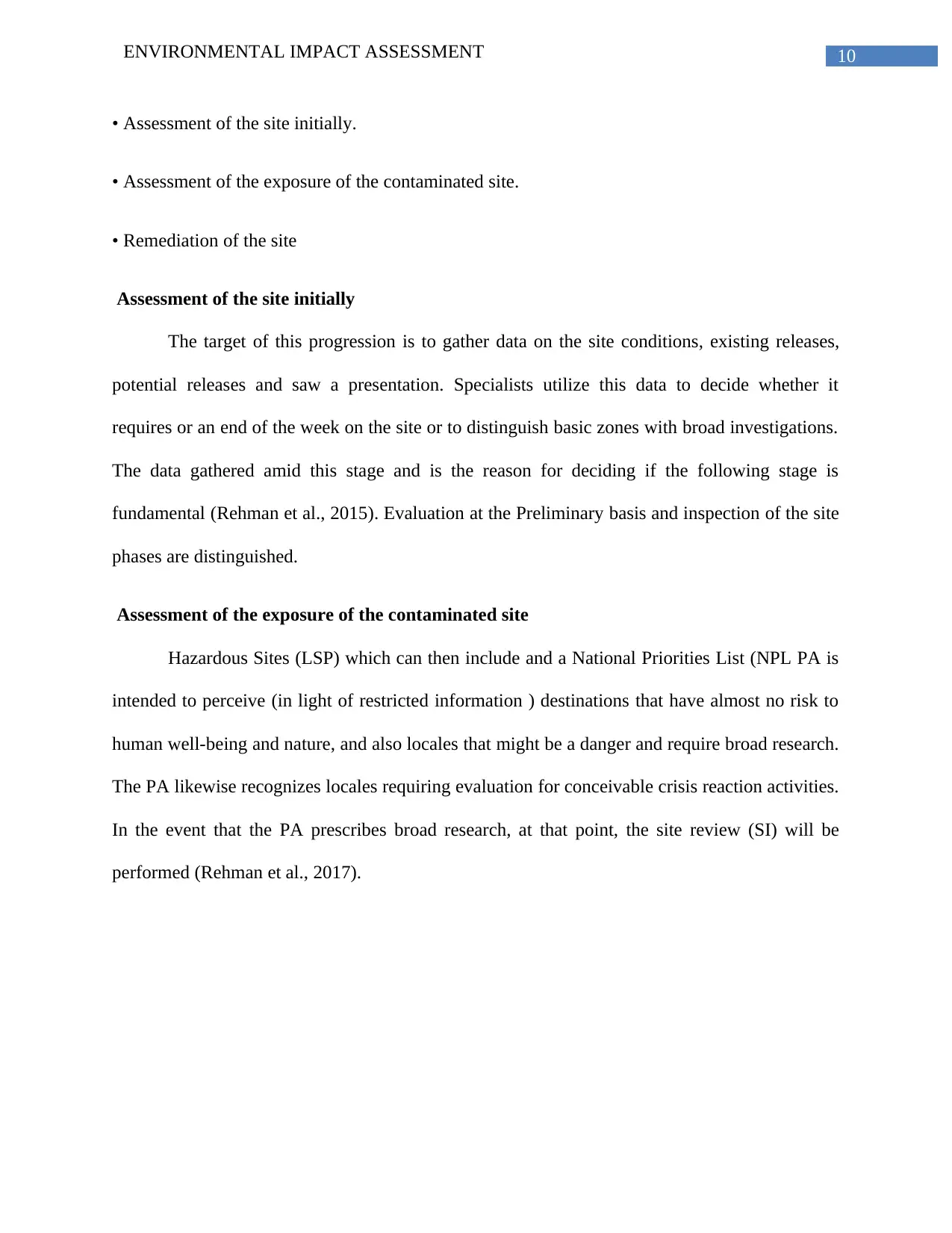
10ENVIRONMENTAL IMPACT ASSESSMENT
• Assessment of the site initially.
• Assessment of the exposure of the contaminated site.
• Remediation of the site
Assessment of the site initially
The target of this progression is to gather data on the site conditions, existing releases,
potential releases and saw a presentation. Specialists utilize this data to decide whether it
requires or an end of the week on the site or to distinguish basic zones with broad investigations.
The data gathered amid this stage and is the reason for deciding if the following stage is
fundamental (Rehman et al., 2015). Evaluation at the Preliminary basis and inspection of the site
phases are distinguished.
Assessment of the exposure of the contaminated site
Hazardous Sites (LSP) which can then include and a National Priorities List (NPL PA is
intended to perceive (in light of restricted information ) destinations that have almost no risk to
human well-being and nature, and also locales that might be a danger and require broad research.
The PA likewise recognizes locales requiring evaluation for conceivable crisis reaction activities.
In the event that the PA prescribes broad research, at that point, the site review (SI) will be
performed (Rehman et al., 2017).
• Assessment of the site initially.
• Assessment of the exposure of the contaminated site.
• Remediation of the site
Assessment of the site initially
The target of this progression is to gather data on the site conditions, existing releases,
potential releases and saw a presentation. Specialists utilize this data to decide whether it
requires or an end of the week on the site or to distinguish basic zones with broad investigations.
The data gathered amid this stage and is the reason for deciding if the following stage is
fundamental (Rehman et al., 2015). Evaluation at the Preliminary basis and inspection of the site
phases are distinguished.
Assessment of the exposure of the contaminated site
Hazardous Sites (LSP) which can then include and a National Priorities List (NPL PA is
intended to perceive (in light of restricted information ) destinations that have almost no risk to
human well-being and nature, and also locales that might be a danger and require broad research.
The PA likewise recognizes locales requiring evaluation for conceivable crisis reaction activities.
In the event that the PA prescribes broad research, at that point, the site review (SI) will be
performed (Rehman et al., 2017).
Paraphrase This Document
Need a fresh take? Get an instant paraphrase of this document with our AI Paraphraser

11ENVIRONMENTAL IMPACT ASSESSMENT
The Statistical Survey of the contaminated site
Serial
Number Places Reviewed Source of
Samples
Turbidity
NTU
Chloride
(mg/L)
Alkalinity
(mg/L)
Calcium
Hardness
(mg/L)
1 Hassan Town Well Water 2.41 3.41 117 43
2 Gujian Well Water 1.76 3.76 313 200
3 Masjid Well Water 2.08 5.08 288 108
4
Banda Darzak
Khan Well Water 2.51 6.51 280 36
5 Banda Jat Khan Well Water 2.78 7.78 463 192
6 Narrian Well Water 1.90 7.90 307 58
7 Lower Malikpura Well Water 2.89 9.89 339 96
8 Gujri Meta Well Water 13.47 21.47 125 106
9 Phool Gulab Well Water 2.50 11.50 335 153
10
Shah Zaman
Colony Well Water 2.28 12.28 331 92
11 Supply Well Water 20.62 31.62 296 83
12 Kakul Bilal Town Well Water 6.80 18.80 374 108
13 Banda Well Water 2.04 15.04 206 75
14 Mirpur Well Water 16.53 30.53 381 163
15 Kehal Well Water 2.26 17.26 230 98
In the above statistical survey it is found the well water of most of the places reviewed
contain a high level of turbidity, chloride, Alkalinity and calcium which is related to the
contaminated land that they belong to.
Statistical modeling
The issue is of essential significance regardless of whether the arsenic focus in
groundwater represents a wellbeing peril, we utilized strategic relapse examination to
demonstrate arsenic fixation in groundwater being above or beneath the WHO rule of 10
and 50 μg/liter. We utilized our own particular groundwater quality information (n =
1184) and in addition those from the beforehand specified investigations, which
constitute 69 extra examples altogether.
The Statistical Survey of the contaminated site
Serial
Number Places Reviewed Source of
Samples
Turbidity
NTU
Chloride
(mg/L)
Alkalinity
(mg/L)
Calcium
Hardness
(mg/L)
1 Hassan Town Well Water 2.41 3.41 117 43
2 Gujian Well Water 1.76 3.76 313 200
3 Masjid Well Water 2.08 5.08 288 108
4
Banda Darzak
Khan Well Water 2.51 6.51 280 36
5 Banda Jat Khan Well Water 2.78 7.78 463 192
6 Narrian Well Water 1.90 7.90 307 58
7 Lower Malikpura Well Water 2.89 9.89 339 96
8 Gujri Meta Well Water 13.47 21.47 125 106
9 Phool Gulab Well Water 2.50 11.50 335 153
10
Shah Zaman
Colony Well Water 2.28 12.28 331 92
11 Supply Well Water 20.62 31.62 296 83
12 Kakul Bilal Town Well Water 6.80 18.80 374 108
13 Banda Well Water 2.04 15.04 206 75
14 Mirpur Well Water 16.53 30.53 381 163
15 Kehal Well Water 2.26 17.26 230 98
In the above statistical survey it is found the well water of most of the places reviewed
contain a high level of turbidity, chloride, Alkalinity and calcium which is related to the
contaminated land that they belong to.
Statistical modeling
The issue is of essential significance regardless of whether the arsenic focus in
groundwater represents a wellbeing peril, we utilized strategic relapse examination to
demonstrate arsenic fixation in groundwater being above or beneath the WHO rule of 10
and 50 μg/liter. We utilized our own particular groundwater quality information (n =
1184) and in addition those from the beforehand specified investigations, which
constitute 69 extra examples altogether.
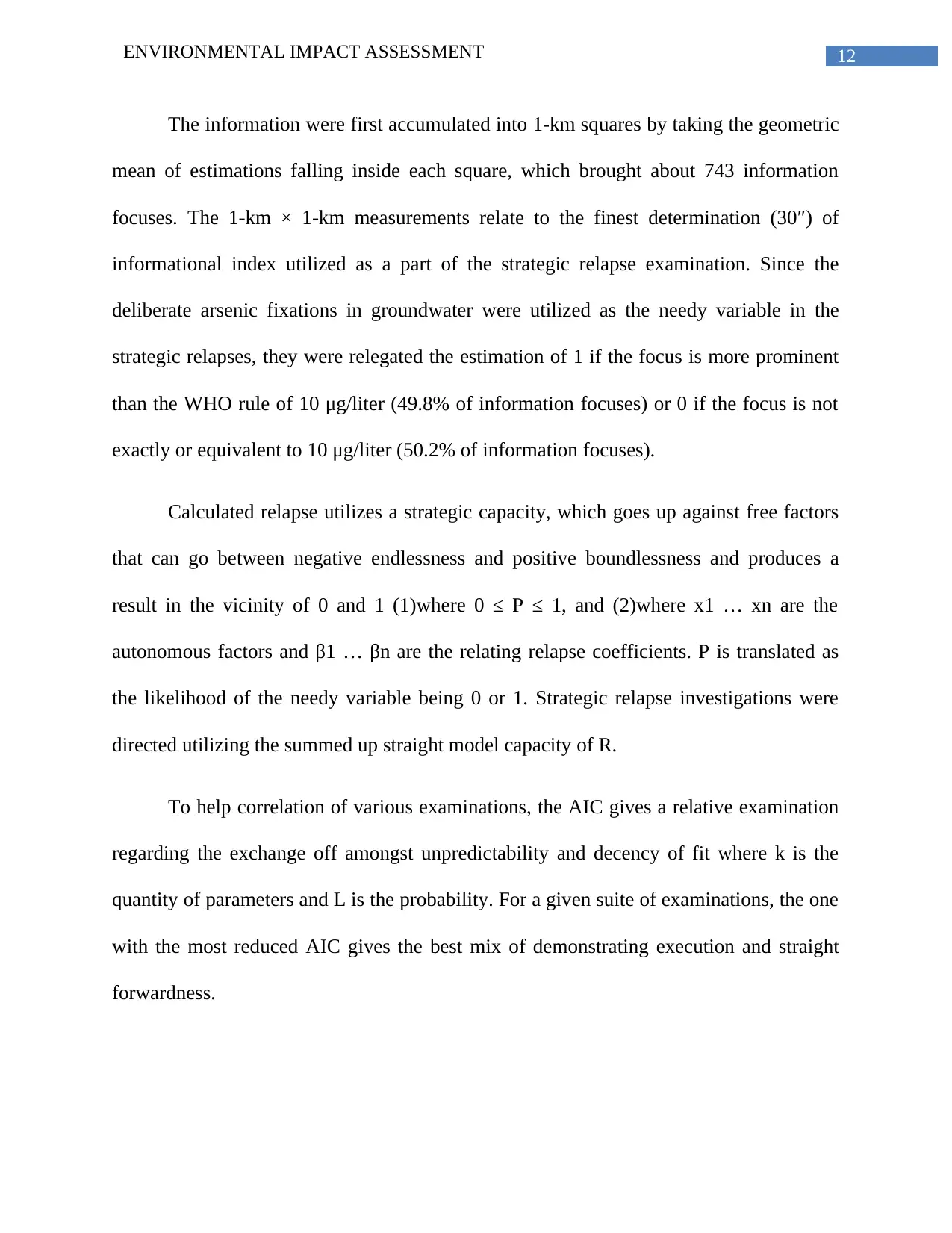
12ENVIRONMENTAL IMPACT ASSESSMENT
The information were first accumulated into 1-km squares by taking the geometric
mean of estimations falling inside each square, which brought about 743 information
focuses. The 1-km × 1-km measurements relate to the finest determination (30″) of
informational index utilized as a part of the strategic relapse examination. Since the
deliberate arsenic fixations in groundwater were utilized as the needy variable in the
strategic relapses, they were relegated the estimation of 1 if the focus is more prominent
than the WHO rule of 10 μg/liter (49.8% of information focuses) or 0 if the focus is not
exactly or equivalent to 10 μg/liter (50.2% of information focuses).
Calculated relapse utilizes a strategic capacity, which goes up against free factors
that can go between negative endlessness and positive boundlessness and produces a
result in the vicinity of 0 and 1 (1)where 0 ≤ P ≤ 1, and (2)where x1 … xn are the
autonomous factors and β1 … βn are the relating relapse coefficients. P is translated as
the likelihood of the needy variable being 0 or 1. Strategic relapse investigations were
directed utilizing the summed up straight model capacity of R.
To help correlation of various examinations, the AIC gives a relative examination
regarding the exchange off amongst unpredictability and decency of fit where k is the
quantity of parameters and L is the probability. For a given suite of examinations, the one
with the most reduced AIC gives the best mix of demonstrating execution and straight
forwardness.
The information were first accumulated into 1-km squares by taking the geometric
mean of estimations falling inside each square, which brought about 743 information
focuses. The 1-km × 1-km measurements relate to the finest determination (30″) of
informational index utilized as a part of the strategic relapse examination. Since the
deliberate arsenic fixations in groundwater were utilized as the needy variable in the
strategic relapses, they were relegated the estimation of 1 if the focus is more prominent
than the WHO rule of 10 μg/liter (49.8% of information focuses) or 0 if the focus is not
exactly or equivalent to 10 μg/liter (50.2% of information focuses).
Calculated relapse utilizes a strategic capacity, which goes up against free factors
that can go between negative endlessness and positive boundlessness and produces a
result in the vicinity of 0 and 1 (1)where 0 ≤ P ≤ 1, and (2)where x1 … xn are the
autonomous factors and β1 … βn are the relating relapse coefficients. P is translated as
the likelihood of the needy variable being 0 or 1. Strategic relapse investigations were
directed utilizing the summed up straight model capacity of R.
To help correlation of various examinations, the AIC gives a relative examination
regarding the exchange off amongst unpredictability and decency of fit where k is the
quantity of parameters and L is the probability. For a given suite of examinations, the one
with the most reduced AIC gives the best mix of demonstrating execution and straight
forwardness.
⊘ This is a preview!⊘
Do you want full access?
Subscribe today to unlock all pages.

Trusted by 1+ million students worldwide
1 out of 22
Related Documents
Your All-in-One AI-Powered Toolkit for Academic Success.
+13062052269
info@desklib.com
Available 24*7 on WhatsApp / Email
![[object Object]](/_next/static/media/star-bottom.7253800d.svg)
Unlock your academic potential
Copyright © 2020–2025 A2Z Services. All Rights Reserved. Developed and managed by ZUCOL.





